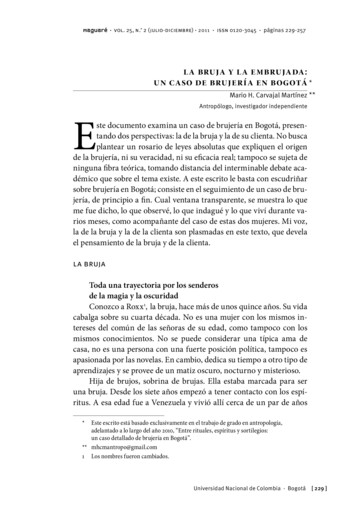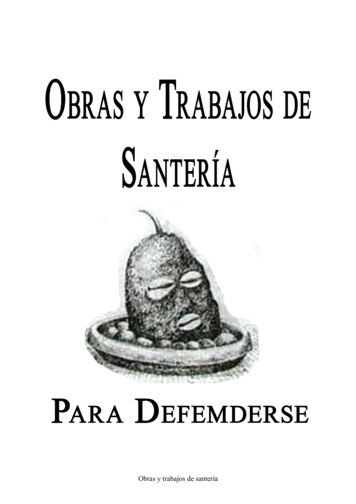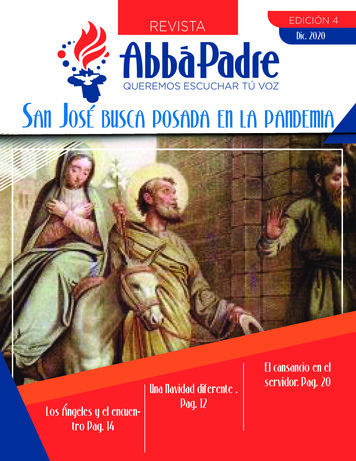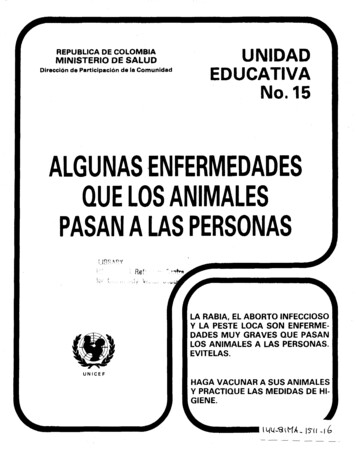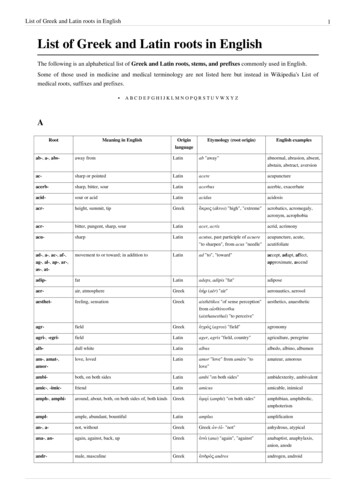
Transcription
PhA.Finamore/Dillon92.vw.c30-07-200215:13Pagina 1IAMBLICHUS DE ANIMA
PhA.Finamore/Dillon92.vw.c30-07-200215:13Pagina 2PHILOSOPHIA ANTIQUAA SERIES OF STUDIESON ANCIENT PHILOSOPHYFOUNDED BY J.H. WASZINK† AND W. J. VERDENIUS†EDITED BYJ. MANSFELD, D.T. RUNIAJ.C.M. VAN WINDENVOLUME XCIIJOHN F. FINAMORE AND JOHN M. DILLONIAMBLICHUS DE ANIMA
PhA.Finamore/Dillon92.vw.c30-07-200215:13Pagina 3IAMBLICHUS DE ANIMAtext, translation, and commentaryBYJOHN F. FINAMORE AND JOHN M. DILLONBRILLLEIDEN BOSTON KÖLN2002
PhA.Finamore/Dillon92.vw.c30-07-200215:13Pagina 4This book is printed on acid-free paper.Library of Congress Cataloging-in-Publication DataIamblichus, ca. 250-ca. 330.De anima / Iamblichus ; Text, translation, and commentary by John F.Finamore and John. M. Dillon.pcm.—(Philosophia antiqua, ISSN 0079-1687; v. 92)Includes bibliographical references and index.ISBN 9004125108 (alk. paper)1. Soul. 2. Iamblichus, ca. 250-ca. 330. De anima. I. Finamore, John F., 1951II. Dillon, John M. III. Title. IV Series.B669.D43 125128’.1—dc2120022002025410CIPDie Deutsche Bibliothek – CIP-EinheitsaufnahmeFinamore, John F.:Iamblichus, De anima : Text, translation, and commentary / by John F.Finamore and John M. Dillon. – Leiden ; Boston ; Köln : Brill, 2002(Philosophia antiqua ; Vol. 92)ISBN 90–04–12510–8ISSN 0079-1687ISBN 90 04 12510 8 Copyright 2002 by Koninklijke Brill NV, Leiden, The NetherlandsCover illustration: Alje OlthofCover design: Cédilles/Studio Cursief, AmsterdamAll rights reserved. No part of this publication may be reproduced, translated, stored ina retrieval system, or transmitted in any form or by any means, electronic,mechanical, photocopying, recording or otherwise, without prior writtenpermission from the publisher.Authorization to photocopy items for internal or personaluse is granted by Brill provided thatthe appropriate fees are paid directly to The CopyrightClearance Center, 222 Rosewood Drive, Suite 910Danvers, MA 01923, USA.Fees are subject to change.printed in the netherlands
For Susan and Jean. . . ouj me;n ga;r tou' ge krei'sson kai; a[reion,h] o{qæ oJmofronevonte nohvmasin oi\kon e[chtonajnh;r hjde; gunhv.
This page intentionally left blank
TABLE OF CONTENTSPreface .ixIntroduction .1Greek Text and English translation of the De Anima .26Commentary to the De Anima .76Greek Text and English translation of Pseudo-Simplicius andPriscianus .229Commentary to Pseudo-Simplicius and Priscianus .252Bibliography .279Index Locorum.286Index Nominum.296Index Rerum .299
This page intentionally left blank
PREFACEThe genesis of this edition goes back to the early 1970’s, when JohnDillon composed a preliminary draft of a text and translation of thesurviving portions of Iamblichus’ De Anima, in the wake of his editionof the fragments of his commentaries on the Platonic dialogues.1 Thisproject, however, went no further at the time, and it was not till manyyears later, in 1986, that Dillon decided to revive it by inviting JohnFinamore, who had recently published a monograph on Iamblichus’theory of the "vehicle" of the soul, 2 which had involved close study ofIamblichus’ De Anima, among other texts, to join him in putting out aproper edition, with commentary, of what remains of this interestingwork. Intensive and continuous work on the project was postponeduntil 1995 after the co-authors had completed other projects of theirown. This present edition is the result of that pleasant cooperation.Iamblichus’ De Anima survives only in the pages of John of Stobi’sEclogae, where it makes up a considerable portion of John’s chapterOn the Soul. John is interested in the work, however, primarily from adoxographic point of view, so that what we have is mainly a surveyand critique of previous opinions. On the other hand, Iamblichus’own doctrinal position does become apparent at various points,particularly in the context of the criticism of his immediatepredecessors, Plotinus, Amelius and Porphyry, and, since most topicsproper to a discussion of the nature and powers of the soul arecovered, it may be that we do in fact have a large part of the work.The idiosyncrasy of Iamblichus’ position, however, only becomesplain when one takes into consideration certain passages from thelater commentary of Pseudo-Simplicius on Aristotle’s De Anima andfrom Priscianus’ Metaphrasis in Theophrastum. We have included thoseas an appendix to this edition.Iamblichus comes, of course, near the end of a long line ofphilosophers who have composed treatises on the soul, or on someaspect of it, and he is himself plainly cognizant of that tradition.1 Iamblichi Chalcidensis in Platonis Dialogos Commentariorum Fragmenta, Leiden:Brill, 1973.2 Iamblichus and the Theory of the Vehicle of the Soul, Chico: Scholars Press, 1985.
xprefaceBeginning in the Old Academy, both of Plato’s immediate successorsSpeusippus and Xenocrates wrote treatises On the Soul (Xenocrates intwo books), though we have no idea of their contents--except, nodoubt, that they incorporated their respective definitions of the soul,both recorded by Iamblichus. Then, of course, there is the survivingtreatise by Aristotle, which forms an essential part of all later discussion, whether one agreed with his doctrine or not. Theophrastus alsocontributed treatises On the Soul and On Sense-Perception, the latter ofwhich survives, while a summary of the former is preserved in theMetaphrasis of Priscianus. The early Stoics also wrote on the subject,notably Zeno and Chrysippus, presenting a doctrine of a unitary soul(though divided into eight parts), distinct from the body--unlikeAristotle’s theory--but interpenetrating it, and composed of materialpneuma. Their doctrine of a unitary soul was disputed by the laterStoic Posidonius, who wrote a treatise On the Soul in at least threebooks, and who reintroduced from Platonism the concept of anirrational as well as of rational soul (for which he is commended byGalen, in his treatise On the Doctrines of Hippocrates and Plato).Among later Platonists, Plutarch composed a treatise On the Soul ofwhich only a few fragments survive, but his treatise On the Creation ofthe Soul in the Timaeus is preserved, and is of great interest, not onlyfor its presentation of his own position, but for its information on thetheories of his predecessors, such as Xenocrates and Crantor. Ofother Middle Platonists, we know of a specific treatise On the Soul onlyfrom the second-century Platonist Severus, though others, such asAtticus and Numenius, certainly had views on the subject of which wehave record, and they all make an appearance in Iamblichus’ work.The work of the later Aristotelian Alexander of Aphrodisias On theSoul was also influential, particularly on Plotinus, though Iamblichushas no occasion to mention him by name.As for Iamblichus’ immediate predecessors, Plotinus does not, ofcourse, compose treatises in the traditional scholastic manner, butvarious of his tractates, notably Ennead 4.3-5, Problems of the Soul, 4.7,On the Immortality of the Soul, and 4.8, On the Descent of the Soul intoBodies, are of importance for Iamblichus (though his references toPlotinus are actually rather non-specific and confused, as we shallsee). Of any relevant treatise by Amelius we know nothing, but fromPorphyry we know of treatises On the Soul and On the Powers of the Soul,fragments of the former of which are preserved by Eusebius, of thelatter by John of Stobi.
prefacexiIamblichus’ treatise, therefore, comes at the end of a very longtradition, of which he is the heir, and to some extent the recorder,and we must be grateful to John of Stobi for preserving even as muchas he did of it.The authors wish to thank the previous and current graduatestudents at the University of Iowa who worked on typing andproofing various sections of the text, especially the Greek text: LisaHughes, Svetla Slaveva-Griffin, Gwen Gruber, and Keely Lake. Dr.Finamore expresses his thanks to the Iowa Humanities Council,whose assistance allowed him to travel to Dublin in April 2000 tomeet with Dr. Dillon and discuss the project.The two authors divided the work of the translation and commentary between them. Although different sections were the primaryresponsibility of one of the authors, both authors read and commented on the sections of the other. In April 2000, the two authorsmet in Dublin to go over and correct the De Anima sections. Theappendix was completed and reviewed by mail and e-mail. The finalresult is a truly collaborative project.The following is the breakdown of the primary responsibility forthe sections of the De Anima and the appendix on the PseudoSimplicius and Priscianus:SectionsPrimary n M. Dillon and John F. Finamore
This page intentionally left blank
INTRODUCTIONI. Iamblichus: Life and Works1Of Iamblichus’ life, despite the biographical sketch of the late fourthcentury sophist Eunapius of Sardis, in his Lives of the Philosophers andSophists,2 little of substance is known. Reading between the lines ofEunapius, however, and helped by pieces of information fromelsewhere, reasonable conjecture can produce probable data.Eunapius reports (VS 457) that Iamblichus was born in Chalcis “inCoele (Syria).” After Septimius Severus' division of the Syrian command in 194 C.E., this refers, not to southern, but to northern Syria,and so the Chalcis in question must be Chalcis ad Belum, modernQinnesrin, a strategically important town to the east of the Orontesvalley, on the road from Beroea (Aleppo) to Apamea, and fromAntioch to the East.3 The date of his birth is uncertain, but thetendency in recent scholarship has been to put it much earlier thanthe traditional date of c.265 C.E. Alan Cameron, in “The Date ofIamblichus' Birth,”4 bases his conclusions on the assumption that theIamblichus whose son Ariston is mentioned by Porphyry (VPlot. 9) ashaving married a lady disciple of Plotinus, Amphicleia, is ourIamblichus. This assumption seems reasonable, since Porphyryexpects his readers to know who this Iamblichus is, and there is noother Iamblichus in this period and milieu. Porphyry's language isambiguous, but to gain a credible chronology, one assumes thatAriston married Amphicleia some time after Plotinus’ death, andprobably not long before 301 C.E., when Porphyry composed the1 For a fuller version of the account given here, see J. Dillon, “Iamblichus ofChalcis” in ANRW II 36:2 (1987), 868-909, itself a revised version of the introduction to his edition of the fragments of Iamblichus’ commentaries on the Platonicdialogues, Iamblichi Chalcidensis in Platonis Dialogos Commentariorum Fragmenta,Leiden, 1973.2 Editions: W.C. Wright, Loeb Classical Library (with Philostratus, Lives of theSophists), Cambridge, 1921; G. Giangrande, Eunapii Vitae Sophistarum, Rome, 1956(page numbering from Boissonade’s edition, Paris, 1822).3 J. Vanderspoel, “Themistios and the Origin of Iamblichos,” Hermes 116 (1988),125-33, has presented an interesting argument in favour of the Chalcis in Lebanon(mod. Anjar), but not so persuasive as to induce me to change my view.4 Hermes 96 (1969), 374-6.
2introductionLife. Even so, and accepting that Ariston was much younger thanAmphicleia, one cannot postulate a date for Iamblichus’ birth laterthan 240 C.E. Iamblichus was not, then, much younger thanPorphyry himself (born in 232), which perhaps explains the ratheruneasy pupil-teacher relationship they appear to have enjoyed.According to Eunapius, Iamblichus was “of illustrious birth, andbelonged to the well-to-do and fortunate classes” (VS 457). It isremarkable that this Semitic name5 was preserved by a distinguishedfamily in this region, when so many of the well-to-do had long sincetaken on Greek and Roman names. But there were, in fact, ancestorsof whom the family could be proud, if the philosopher Damasciusmay be believed. At the beginning of his Life of lsidore, 6 he reportsthat Iamblichus was descended from the royal line of thc priest-kingsof Emesa. Sampsigeramus, the first of these potentates to appear inhistory, won independence from the Seleucids in the 60’s B.C.E., andwas in the entourage of Antony at the Battle of Actium. He left a sonIamblichus to carry on the line, and the names “Sampsigeramus” and“Iamblichus” alternate in the dynasty until the end of the first centuryC.E., when they were dispossessed by Domitian. Inscriptional evidence, however, shows the family still dominant well into thc secondcentury.7How or why a branch of the family got to Chalcis by the thirdcentury is not clear, but it may have been the result of a dynasticmarriage, since Iamblichus' other distinguished ancestor mentionedby Damascius is Monimus (Arabic Mun eim). This is not an uncommon name in the area, but the identity of the Monimus inquestion may be concealed in an entry by Stephanus of Byzantium(s.v. Chalcis), which reads: “Chalcis: fourth, a city in Syria, founded byMonicus thc Arab.” Monicus is a name not found elsewhere, and maywell be a slip (either by Stephanus himself or a later scribe) for‘Monimus.’ This would give Iamblichus an ancestor of suitabledistinction, none other than the founder of his city.8 What may have5 The original form of Iamblichus’ name is Syriac or Aramaic: yamliku, a thirdperson singular indicative or jussive of the root MLK, with El understood, meaning“he (sc. El) is king”, or “May he (El) rule!”.6 Ed. C. Zintzen, Hildesheim, 1967, 2; and now P. Athanassiadi, Damascius, ThePhilosophical History (Athens, 1999).7 Inscriptions grecques et latines de la Syrie V, 2212-7. Cf. also John Malalas, Chron.296.8 Unless in fact the reference is to the god Monimos, attested by Iamblichushimself (ap. Julian, Hymn to King Helios, 150CD) worshipped at Emesa in associationwith the sun god. The royal family may conceivably have traced their ancestry to
introduction3happened is that a daughter of the former royal house of Emesamarried into the leading family of Chalcis, and one of her sons wascalled after his maternal grandfather.There is no doubt, at any rate, that Iamblichus was of good family.Such an ancestry may have influenced his intellectual formation. Histendency as a philosopher, manifested in various ways, is always toconnect Platonic doctrine with more ancient wisdom (preferably, butnot necessarily, of a Chaldaean variety), and within Platonism itself itis he who, more than any other, is the author of the ramified hierarchy of levels of being (many identified with traditional gods andminor divinities) which is a feature of the later Athenian Platonism ofSyrianus and Proclus. With Iamblichus and his advocacy of theurgy asa necessary complement to theology, Platonism also becomes moreexplicitly a religion. Before his time, the mystery imagery so popularwith Platonist philosophers (going back to Plato himself) was, so faras can be seen, just that--imagery. With Iamblichus, there is anearnest emphasis on ritual, enabling thc Emperor Julian to found hischurch on this rather shaky rock.The mid-third century was a profoundly disturbed time to begrowing up in Syria. In 256 C.E., in Iamblichus' early youth, thePersian King Shapur broke through the Roman defenses aroundChalcis (the so-called limes of Chalcis), and pillaged the whole northof Syria, including Antioch (Malalas, Chron. 295-6). It is not knownhow Iamblichus' family weathered the onslaught. Being prominentfigures, especially if they were pro-Roman, they may well havewithdrawn before it and sought refuge temporarily on the coast.At this point, the problem arises of who Iamblichus' teachers inphilosophy were. Eunapius writes of a certain Anatolius, meta;Porfuvrion ta; deuvtera ferovmenow (VS 457). This phrase in earliertimes simply means “take second place to”9 but a parallel in Photius10suggests that for Eunapius the phrase meant “was successor to.” If thisis so, it poses a problem. It has been suggested11 that Iamblichus'teacher is identical with the Anatolius who was a teacher of Peripatetic philosophy in Alexandria in the 260's and later (in 274)consecrated bishop of Laodicea in Syria. This suggestion, however,comes up against grave difficulties: chronology requires thatthis deity, identified with planet Mercury.9 e.g. in Herodotus, 8. 104.10 Bibl. 181 Damascius, V. Isid. 319, 14 Zintzen.11 Dillon, 1987, 866-7.
4introductionIamblichus was a student no later than the 270's, so that it must beconcluded that we have to do here with another Anatolius (thededicatee of Porphyry's Homeric Questions ( JOmhrikaŸ zhthvmata), andso probably a student of his) who represented in some way Porphyryduring his absence (perhaps still in Sicily?). This, however, assumes asituation for which there is no evidence, namely that Porphyryestablished a school in Rome between his visits to Sicily, or thatPlotinus had founded a school of which Porphyry was the titular headeven in his absence in Sicily. Another possibility, of course, is thatEunapius is profoundly confused, but that conclusion seems to be acounsel of despair.When Porphyry returned from Sicily to Rome is not clear.Eusebius, writing sometime after his death (c. 305 C.E.), describeshim (HE VI 19,2) as “he who was in our time established in Sicily” (oJkaq j hJma ejn Sikeliva/ katastav ) which suggests a considerable stay. J.Bidez,12 however, takes this as referring only to the publication ofPorphyry's work Against the Christians. Porphyry refers to himself ashaving returned to Rome at Plot. 2, but when that happened he doesnot indicate. That he returned by the early 280's, however, is aproposition with which few would disagree, and if Iamblichus studiedwith him, it would have occurred in this period. The only (more orless) direct evidence of their association is the dedication toIamblichus of Porphyry's work On the maxim “Know Thyself.”13What the relationship between the two may have been cannot bedetermined. In later life Iamblichus was repeatedly, and oftensharply, critical of his master's philosophical positions. This can beseen in his Timaeus Commentary, where, of thirty-two fragments inwhich Porphyry is mentioned, twenty-five are critical, only sevensignifying agreement. The same position is evident also in thecommentary on Aristotle's Categories, as preserved by Simplicius, butthere Simplicius reports that Iamblichus based his own commentaryon that of Porphyry 14 (something also likely for his T i m a e u sCommentary), so that such statistics given previously are misleading.12Vie de Porphyre (Ghent and Leipzig, 1913) 103 note 1.Unless account be taken of Iamblichus’ assertion in the De Anima (375.24-25)that he had ‘heard’ Porphyry propound a certain doctrine. The verb akouô with thegenitive came to be used in peculiar ways in later Greek, however, denotingacquaintance at various removes, so that one cannot put full trust in this testimony.There is no real reason, on the other hand, to doubt that Iamblichus and Porphyrywere personally acquainted.14 In Cat. 2, 9ff. Kalbfleisch.13
introduction5However, the De Mysteriis is a point-by-point refutation of Porphyry'sLetter to Anebo (which, in turn, was an attack on theurgy probablyaimed at Iamblichus), and Iamblichus' references to Porphyry in theDe Anima are generally less than reverent. No doubt, also, Iamblichus'lost work On Statues had much to say in refutation of Porphyry's workof the same name.There is no need, however, to conclude that Iamblichus learnednothing from Porphyry, or that they parted on bad terms. Therefutation of one's predecessors was a necessary part of staying afloatin the scholarly world, then as now, and Iamblichus was enough of anoriginal mind to have many modifications and elaborations tointroduce into Porphyry’s relatively simple metaphysical scheme. Alsocontact with Plotinus was a personal experience for Porphyry, whichit was not for Iamblichus. This has some bearing, along with theconsiderations of ancestry mentioned earlier, on Iamblichus' enthusiasm for theurgy, an enthusiasm of Porphyry himself in his youth,which was something direct contact with Plotinus tended to suppress.When Porphyry wrote his Letter to Anebo, he was actually providing arecantation of his earlier beliefs, as expressed in the Philosophy fromOracles.Even as it is not known when or where15 Iamblichus studied withPorphyry, so it is not known when he left him, returned to Syria andfounded his own school. From the fact that he returned to Syria,rather than staying on as successor to Porphyry (he was, after all, hismost distinguished pupil), one might conclude that there was tensionbetween them. But Iamblichus by the 290's would already be, if ourchronology is correct, a man of middle age, and it is natural enoughthat he should want to set up on his own. Porphyry, after all, did notdie until after 305 at the earliest, and probably Iamblichus departedlong before that.For Iamblichus' activity on his return to Syria one is dependent onEunapius' account, which, with all its fantastic anecdotes, is claimedby its author to rest on an oral tradition descending to him fromIamblichus' senior pupil Aedesius, via his own revered masterChrysanthius. Unfortunately, Eunapius is vague on details of primeimportance. Where, for example, did Iamblichus establish his school?The evidence seems to be in favor of Apamea, rather than his nativeChalcis. This is not surprising: Apamea had been a distinguished15It is conceivable, after all, that he went to study with him in Lilybaeum.
6introductioncenter of philosophy for well over a century (at least), and was thehome town, and probably base, of the distinguished second centuryNeopythagorean Numenius. It was also the place to which Plotinus'senior pupil Amelius retired in the 260’s, no doubt because ofadmiration for Numenius. Amelius was dead by the time Porphyrywrote his Commentary on the Timaeus (probably in the 290's), but heleft his library and possessions to his adopted son HostilianusHesychius, who presumably continued to reside in Apamea.Once established in Apamea,16 Iamblichus seems to have acquiredsupport from a prominent local citizen, Sopater, and in Eunapius'account (VS 458-9), he is portrayed as being in possession of anumber of suburban villas (proavsteia) and a considerable group offollowers. There are glimpses of him in the midst of his disciples,discoursing and fielding questions, disputing with rival philosophers,and leading school excursions to the hot springs at Gadara. Iamblichus had strong Pythagorean sympathies, inherited from Numeniusand Nicomachus of Gerasa, and one would like to know how far histreatise On the Pythagorean Way of Life reflects life in his own school.Probably not very closely, in such matters as community of propertyor long periods of silence, or we would have heard about it fromEunapius. More likely the school of Iamblichus was like anycontemporary philosophic school in the Platonist tradition, a groupof students living with or round their teacher, meeting with himdaily, and probably dining with him, pursuing a set course of readingand study in the works of Aristotle and Plato, and holding disputations on set topics.Possibly Iamblichus' ten volumes on Pythagoreanism, entitledcollectively A Compendium of Pythagorean Doctrine, constituted an introductory course for his school. It is plain that there was study of atleast some Aristotle, the logical works (Iamblichus, as we have seen,wrote a copious commentary on the Categories, heavily dependent onthat of Porphyry, but with transcendental interpretations of his own),the De Anima, and perhaps parts of the Metaphysics, followed by thestudy of Plato. For Plato, Iamblichus, building on earlier, Middle16 There is some conflicting evidence, from Malalas (Chron. XII 312, 11-12),indicating that Iamblichus was established with a school at Daphne, near Antioch,in the reigns of Maxentius and Galerius (305-312 C.E.), and Malalas says that hecontinued teaching there until his death. Malalas, despite his limitations, is notentirely unreliable on matters affecting his home area, so it is possible thatIamblichus spent some time in Daphne; there is no doubt, however, that Apameawas his main base.
introduction7Platonic systems of instruction (such as described in Albinus'Eisagôgê), prescribed a definite number and order of dialogues to bestudied. In the Anonymous Prolegomena to Platonic Philosophy17 ch. 26,there is a course of ten dialogues attributed originally to Iamblichus,starting with the Alcibiades I, and continuing with Gorgias, Phaedo,Cratylus, Theaetetus, Sophist, Statesman, Phaedrus, Symposium and Philebus, leading to the two main dialogues of Platonic philosophy, theTimaeus and the Parmenides, the former “physical,” the latter “theological.” Of these, there are fragments or evidence of commentariesby Iamblichus on the Alcibiades, Phaedo, Sophist, Phaedrus, Philebus,Timaeus, and Parmenides, the most extensive (preserved in Proclus'commentary on the same dialogue) being those on the Timaeus. It issurprising not to find any mention in this sequence of either theRepublic or the Laws. They were probably regarded as too long, and inthe main too political, to be suitable for study as wholes, but there isindication that sections such as Republic 6, 7, and 10, and Laws 10,received due attention.Formal exegesis then, played a significant part in the curriculumof the school, but notice must also be taken of the reputation whichIamblichus acquired in later times (mainly because of the excesses ofsuch epigoni as Maximus of Ephesus, the teacher of Julian in the350's) for magical practices. He probably used the Chaldaean Oraclesin lectures, since he composed a vast commentary (in at least 28books) on the Oracles. There is only one story related by Eunapius inwhich Iamblichus is said to have performed a magical act, and thatwas during the above-mentioned visit of the school to the hot springsat Gadara. Iamblichus, in response to insistent requests, conjured uptwo spirits in the form of boys, identified as Eros and Anteros, fromtwo adjacent springs (VS 459). On another occasion, however (VS458), he is recorded as dismissing with a laugh rumors that duringprayer he was accustomed to rise ten cubits into the air, and that hisbody and clothing took on a golden hue. Nevertheless, his championing of theurgy (which is really only magic with a philosophicalunderpinning), presented at length in the De Mysteriis, introduced anew element into Platonism, which was to continue even up to theRenaissance. Partly this was a response to a Christian emphasis on themiracle-working holy man. It might have happened without Iamblichus, but certain elements in his background perhaps disposed him17Ed. L. G. Westerink (Amsterdam, 1962).
8introductionto making Platonism into more of a religion than had hitherto beenthe case.The details of Iamblichus' philosophical system are not relevant tothe present work, which concerns only the soul, not Iamblichus'complete metaphysical hierarchy. We will discuss Iamblichus' psychology below.Iamblichus seems to have lived in Apamea until the early 320’s. Aterminus is found in Sopater's departure for Constantinople to try hisluck with imperial politics in 326/7, by which time his revered masterwas certainly dead. A most interesting testimony to Iamblichus' statusin the 320's is provided by the letters included among the works ofthe Emperor Julian.18 These were composed by an admirer of Iamblichus between the years 315 and 320, who was then attached to thestaff of the Emperor Licinius. This person cannot be identified,19 butEunapius (VS 458) gives the names of various disciples, Aedesius andEustathius (who was Iamblichus' successor) from Cappadocia, andTheodorus (presumably Theodorus of Asine) and Euphrasius frommainland Greece. Besides these it is possible to identify Dexippus,author of a surviving commentary on Aristotle's Categories, and Hierius, master of the theurgist Maximus of Ephesus. To some of thesethere is a record of letters on philosophical subjects by Iamblichus(Sopater, Dexippus and Eustathius, at least). One is even tempted towonder whether the recipient of a letter O n Ruling, a certainDyscolius (perhaps identical with a governor of Syria around 323)20may not be the mysterious correspondent mentioned above. But evenif that were known we would not really be much wiser.A little more may be said on the rest of Iamblichus' known literaryproduction. His De Mysteriis, more properly entitled A Reply of thePriest Abammon to the Letter of Porphyry to Anebo, and the Solution of theProblems Raised Therein, is a defense of theurgy against a series ofskeptical questions raised by Porphyry. On the Gods was much used byJulian and probably served as a chief source for the surviving work of18 Epp. 181, 183-7 Bidez-Cumont ( 76-8, 75, 74, 79 Wright, LCL). How they fellinto the hands of Julian, or came to be included among his works, is uncertain, buthe was avid collector of Iamblichiana. On this person, see T.D. Barnes, “ACorrespondent of Iamblichus,” GRBS 19 (1978), 99-106, who sorts out theproblems connected with him most lucidly.19 An intriguing possibility, not raised by Barnes, is that this person may havebeen none other than Julius Julianus, Julian’s maternal grandfather, who had bee
philosophia antiqua a series of studies on ancient philosophy founded by j.h. waszink† and w.j. verde

